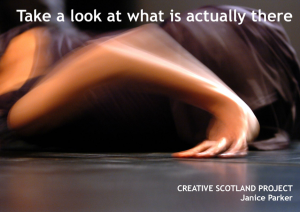 In 2005, Janice Parker received a Creative Scotland Award from the Scottish Arts Council to enable her to spend a year exploring new depths within her work and creating new points of departure.
In 2005, Janice Parker received a Creative Scotland Award from the Scottish Arts Council to enable her to spend a year exploring new depths within her work and creating new points of departure.
The plan was to immerse herself practically in the creative process of making work – starting points, end points, motivations and possibilities. The result was a fascinating short publication called ‘Take a look at what is actually there’.
Within it Janice explores her relationship with movement – in particular the movement of learning disabled dancers. She does this with political intent, but overridingly with an artistic gaze:
Working with dancers who do not conform to the usual or expected social and aesthetic norms can add to the existing performance aesthetic and contribute to the field of performance art.
For Janice, this is rich artistic territory that has the potential to impact on the way in which we all see dance, and indeed on the dance sector itself. It’s a real example of ‘creative case’ thinking – where the root of mainstream change can be mapped back to the creative potential of disabled people to break the mould and challenge conventional ways of thinking.
Janice is clear that this is not a ‘how to’ manual:
There is no one method or model of working with people with learning disabilities, there is only art and artists.
Underpining the work, the politics. They have to be present given the nature of the inequality experienced by learning disabled people, and disabled people generally.
There is an attitude in our culture where a person with a disability is constantly seen as needing help; where dance is only considered as a service that is offered; and performance a way to overcome problems. I find this a very limited and limiting understanding… I believe that many individuals with a learning disability have the potential to contribute directly to the art form, to influence the mainstream and to provide something uniquely their own that artists might aspire to.
And through Janice’s continuing work they do. Private Dancer is a brilliant example of just that.